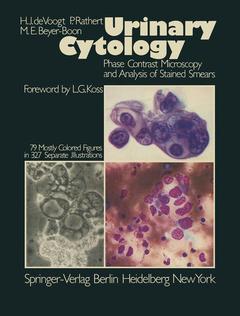Urinary Cytology, Softcover reprint of the original 1st ed. 1977 Phase Contrast Microscopy and Analysis of Stained Smears
Langue : Anglais
Auteurs : Voogt H.J.de, Beyer-Boon M.E., Rathert P.

Cytologic diagnosis of cancer has its roots in clinical micro scopy as it was shaped during the first half of the 19th century. In reviewing some of the early writing on this subject, one is amazed at the accuracy of the descriptions and soundness of the observations. Cytology of the urine is no exception: in 1864 Sanders described fragments of cancerous tissue in the urine of a patient with bladder cancer (Edinburgh Med. J. 111, 273). This observation was confirmed by Dickinson in 1869 (Tr. Path. Soc. London, 20, 233). It is a source of special pride to me that in 1892 a New York pathologist, Frank Ferguson, advocated the examination of the urinary sediment as a best means of diagnosing bladder cancer, short of cystoscopy. Papanico laou freely acknowledged these contributions while estab lishing sound scientific bases for continuation and spread of this work. Papanicolaou's work in the area of the urinary tract has not fallen on dead ears. He documented to several urologists who were within his sphere of personal influence, mainly Dr. Victor Marshall, Professor of Urology at Cor nell University Medical School, that urinary tract cytology was a reliable tool in the diagnosis of urothelial carcinoma. Some of us who have attempted to spread the master's word had their share of success within institutions with which we were associated.
1. Clinical Application of Urinary Cytology.- 2. Preparatory Techniques.- 2.1. Collection of Material.- 2.1.1. Urine.- 2.1.2. Bladder and Renal Plevis Washings.- 2.1.3. Brushing Techniques.- 2.1.4. Prefixation.- 2.2. Cell Concentration Techniques.- 2.3. Smear Preparation Techniques.- 2.3.1. Smears for Phase Contrast Microscopy and Methylene Blue Staining (Non-Permanent)..- 2.3.2. Smears for the Papanicolaou Stain (Permanent).- 2.3.2.1. Smears form Freshly Voided Urine.- 2.3.2.2. Smears from Prefixed Urine.- 2.3.2.3. Smears for the MGG Method (Permanent)..- 2.4. Staining Methods.- 2.4.1. Methylene Blue Stain.- 2.4.2. Papanicolaou Stain.- 2.4.3. May-Gruenwald Giesma Staining Method..- 2.5. Pitfalls.- 2.5.1. Cell Degeneration.- 2.5.2. Formalin Effect.- 2.5.3. The Damaging Effect of Hypertonic Urine.- 2.5.4. Cell Loss During Staining.- 2.5.5. Overstaining.- 2.5.6. Cellular and Nuclear Shrinkage.- 3. Urinary Cytology and its Relationship to Histology of the Urinary Tract.- 3.1. Normal Structure of Urothelium.- 3.1.1. Histology of Normal Urothelium.- 3.1.2. Epithelial Variants.- 3.1.3. Cytology of Normal Urothelium.- 3.2. Epithelial Contamination.- 3.3. Benign Urothelial Lesions.- 3.3.1. Inflammatory Changes.- 3.3.1.1. Bacterial Infections.- 3.3.1.2. Viral Infections.- 3.3.1.3. Parasitic Infections.- 3.3.1.4. Mycotic Infections.- 3.3.2. Malakoplakia.- 3.3.3. Squamous Metaplasia.- 3.3.4. Glandular Cystitis.- 3.3.5. Urinary Calculi.- 3.3.6. Hyperplasia of the Urothelium.- 3.3.7. Atypical Hyperplasia of the Urothelium.- 3.3.8. Condylomata Acuminata.- 3.4. Urothelial Tumors.- 3.4.1. Introduction.- 3.4.2. Classification of Urothelial Tumors.- 3.4.2.1. Macroscopy.- 3.4.2.2. Microscopy.- 3.4.2.3. Stage.- 3.4.2.4. Clinical Classification (UICC).- 3.4.3. Macroscopy and Histology of Pure Transitional Cell Tumors.- 3.4.3.1. Papillary Tumors.- 3.4.3.2. Solid Tumors.- 3.4.3.3. Flat Intra-Epithelial Carcinomas (Carcinoma in situ).- 3.4.4. Cytology of Pure Urothelial Tumors.- 3.4.4.1. Papillary Tumors Grade 0 (Benign Papilloma) and Grade 1 (Papilloma with Atypia).- 3.4.4.2. Papillary Tumors, Grade 2, 3 and 4 (Carcinomas).- 3.4.4.3. Solid Urothelial Carcinomas.- 3.4.4.4. Carcinoma in situ.- 3.4.5. Squamous Differentiation of Transitional Cell Carcinoma and Pure Squamous Cell Carcinoma.- 3.4.6. Adenomatous Differentiation of Transitional Cell Carcinoma and Pure Adenocarcinoma..- 3.5. Adenocarcinoma of the Prostate.- 3.6. Infiltration of the Bladder or Ureter from Adjacent Carcinomas and Metastasis of other Carcinoma.- 3.7 Adenocarcinoma of the Kidney.- 3.8. Effect of Radiation on the Urothelium.- 3.9. Effect of Cancer Drugs.- 4. Phase Contrast Microscopy of the Urinary Sediment.- 5. Methylene Blue Stain of the Urinary Sediment.- 6. Epidemiology and Etiology of Urothelial Tumors.- 7. Efficacy of Urinary Cytology in the Detection of Tumors of the Urinary Tract.- 7.1. Diagnosis of Patients with positive Cytological Results.- 7.2. Diagnosis of Patients with Atypical Findings.- 7.3. Sensitivity and Specificity of Urinary Cytology.- 7.4. The Validity of the Provisional Contrast Microscopy Diagnosis.- 7.4.1. Phase Contrast Microscopy Underdiagnosis..- 7.4.2. Phase Contrast Microscopy Overdiagnosis..- Acknowledgement.- References.- Illustrations.- 1. Normal Transitional Epithelium.- 2. Inflammatory Changes.- 3. Non-Bacterial Inflammations and Contaminants.- 4. Atypical Hyperplasia.- 5. Phase Contrast Microscopy: Criteria for Malignancy.- 6. Grade 1 Tumors of the Bladder.- 7. Grade 2 Tumors of the Bladder, with and without Infiltrative Growth.- 8. Grade 2 Bladder Tumors and Grade 3 Uroteral Tumor.- 9. Grade 2 Tumors of Bladder and Urethra with Infiltrative Growth.- 10. Grade 3 Tumors of Bladder, Renal Pelvis and Ureter.- 11. Grade 3 Tumors of Renal Pelvis, Ureter and Bladder.- 12. Grade 4 Bladder Tumors.- 13. Grade 4 Solid Carcinoma of the Bladder.- 14. Carcinoma in situ.- 15. Squamous Cell Carcinoma of the Bladder.- 16. Adenomatous Differentiation.- 17. Adenocarcinoma.- 18. Adenocarcinoma of Kidney.- 19. Bladder Cancer and Prostate Cancer.- 20. Cystitis Glandularis Combined with Squamous Metaplasia.- 21. Effects of Radiation.- 22. Effects of Cytostatic Drugs on Urothelial Cells.- 23. Cytological Changes Due to Urinary Calculi.- 24. Catheter Urine.- 25. Ileal Stomal Urine.- 26. Artifacts in PCM.
Date de parution : 03-2012
Ouvrage de 196 p.
21x27.9 cm
Disponible chez l'éditeur (délai d'approvisionnement : 15 jours).
Prix indicatif 105,49 €
Ajouter au panierThèmes d’Urinary Cytology :
© 2024 LAVOISIER S.A.S.



